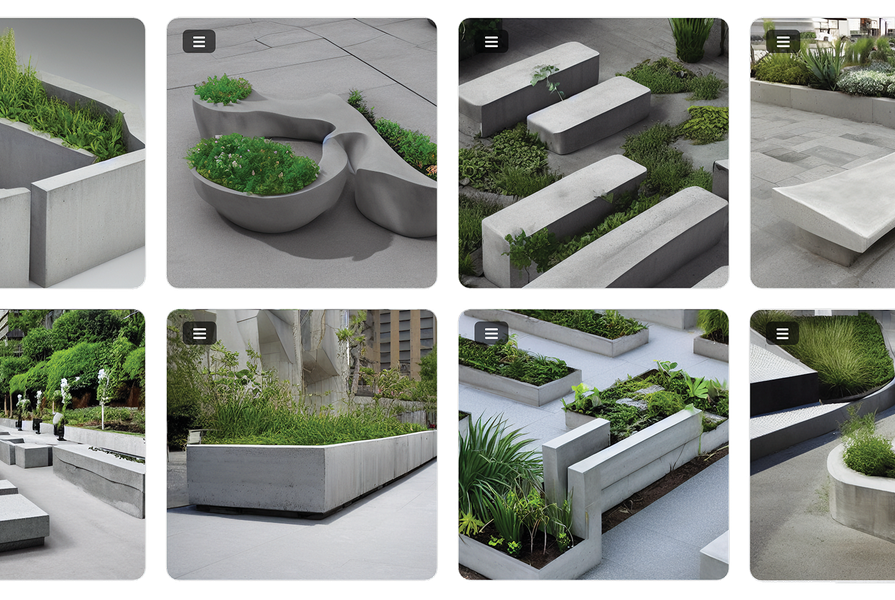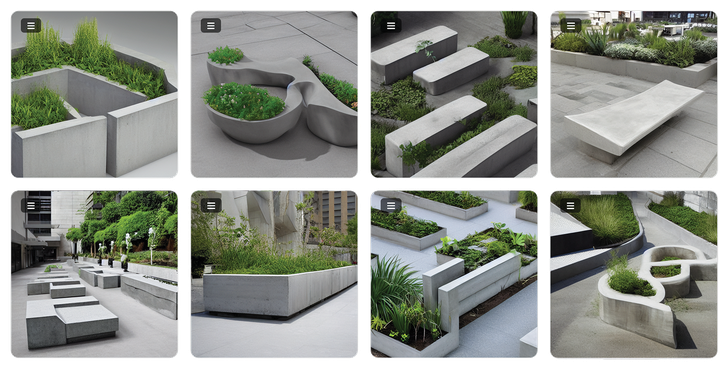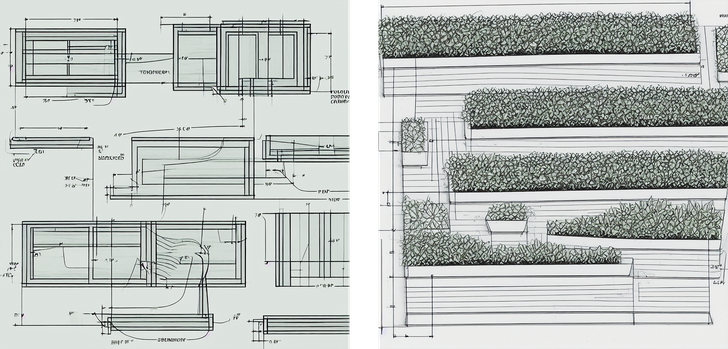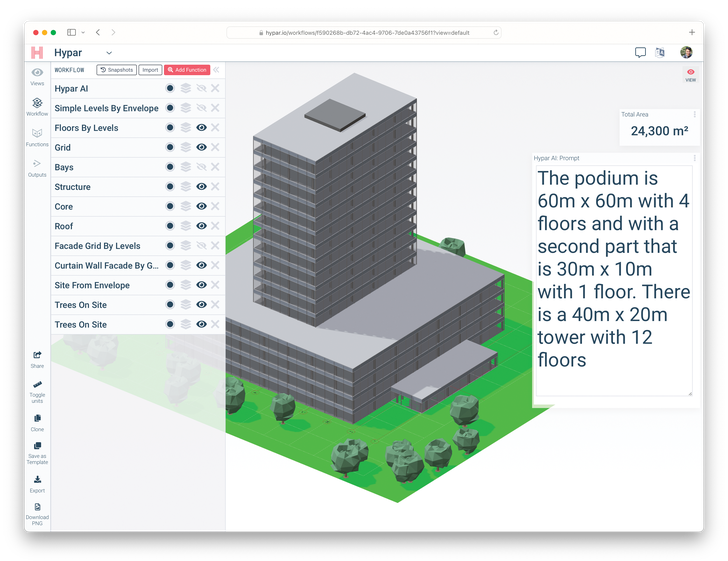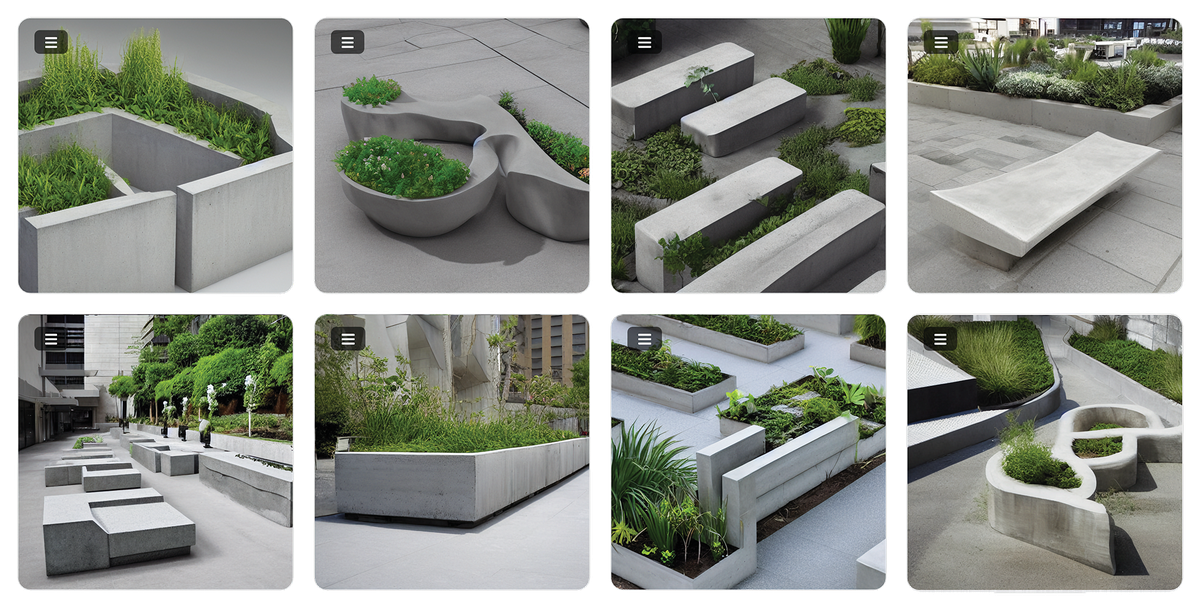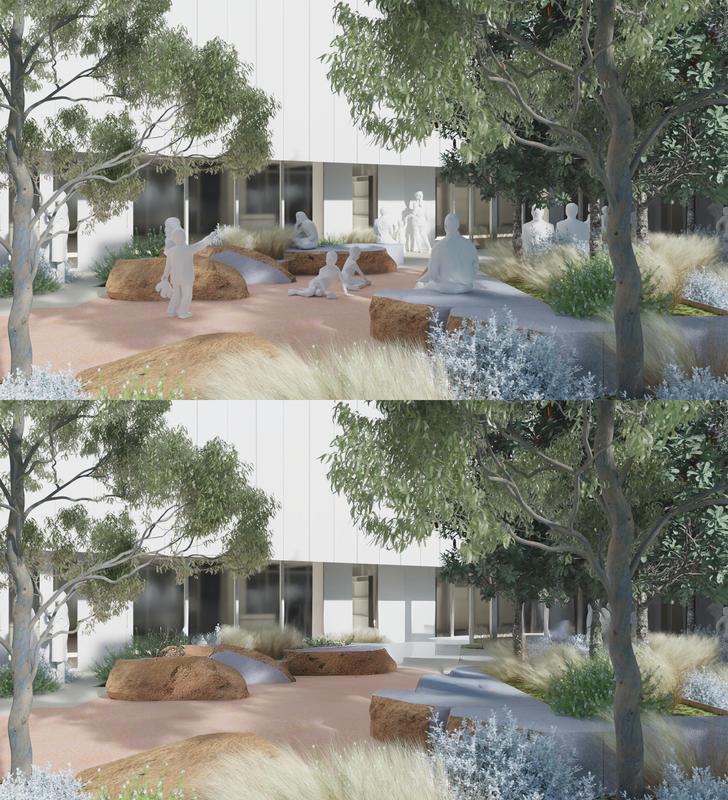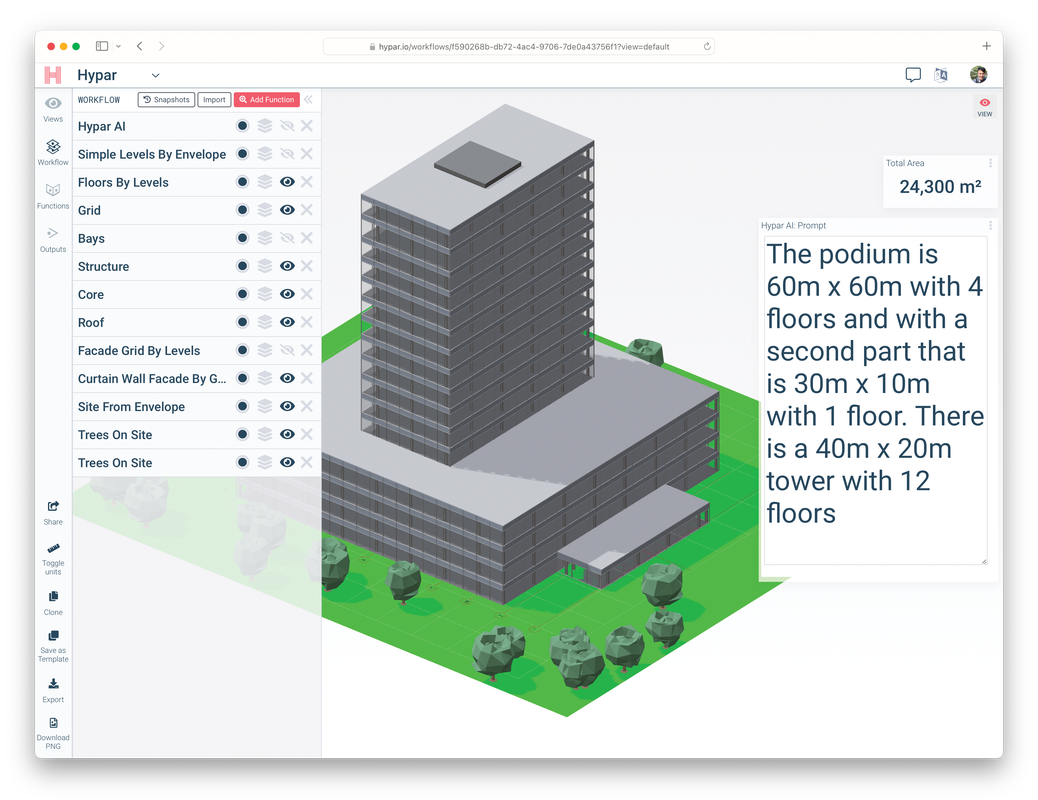Designing landscapes is a prophetic act. What will this copse look like in a decade? How might the uses and users of this space evolve? These questions are a typical part of the design process, with answers found through experience, education and precedent. However, the rapid evolution of AI-powered design tools is raising new ways to ask – and answer – questions about how landscapes perform and how landscape architects design.
Up until very recently, most AI fanfare in landscape architecture focused on enhancing our use of analysis and simulation. One example of this is at Sydney’s Bicentennial Park, where an AI model analysed soil moisture data to help direct maintenance strategies to enhance the park’s microclimates.1 Similarly, international design practice SWA has deployed AI to analyse video feeds of people interacting with public space as part of a research report that investigated the design of plazas.2
Even more speculative explorations have imagined AIs reacting to data derived from real landscapes and real landscape phenomena. For instance, the work of US-based landscape architect Bradley Cantrell has explored how AI could act as an intermediary between the capabilities of landscape architects and the complexities of environmental systems.3 Following this approach, an AI’s analysis of ecosystem data could highlight where to intervene during a rewilding campaign – perhaps predicting which riverbanks are most erosion-prone or where new plantings would best thrive.
In each of these examples, the AI model is highly attuned to landscape data. If these models are to succeed, they need datasets that are highly specific and highly detailed. However, landscape architects do not typically produce or employ huge datasets in our work.4 As a result, the use of AI in landscape architecture seemed to be highly constrained – applicable only to unusually large-scale or long-term projects and close collaborations with more data-driven disciplines.
AI’s generative turn
The recent emergence of a new type of AI – the “large language model” – has changed this forecast by introducing a range of new capabilities that can be applied across many fields. Rather than excelling at analysis, this newer type of AI model can perform more generative tasks, such as creating text and imagery. To do so, the model must have first analysed a huge trove of data and identified which words most often follow other words – e.g. “blue” appearing after “the sky is” – across a variety of contexts. These predictions, once strung together into sentences and paragraphs, create a kind of super-powered autocomplete that can generate a response to a given question. Conveniently, the same approach can be applied to generate images by (essentially) treating clusters of pixels as if they were sentences that represent a particular shape or subject.
Unlike earlier iterations of AI, this type of model is also very accessible. Many models can be used through a website, while others can be downloaded for free as standalone desktop applications. Whether accessed online or through an app, generative AI tools are also surprisingly easy to employ; users simply write a short prompt that describes what the AI should try to create.
AI in the design process
Prompting an AI model with a typed-up design brief and expecting it to generate a comprehensive master plan will lead to rather disappointing results. However, a much more specific and tactical use of AI tools can enhance (not replace) many tasks in the design process.
When developing a design concept, image-generating AI models can produce interesting results when given narrowly defined prompts that describe elements of a design. This sees AI play the role of a quick sketch, a well-sourced Pinterest board or an OMA-like army of foam-cutting interns: a method of loosely directed exploration that might inform a designer’s typical process of ideation and iteration.
A series of images created by entering the text: “Creative and unusual concrete bench designs with integrated planter elements and rough gray concrete with fractured or curvilinear forms. Shown in a tiled plaza. Incorporating design elements in the style of Carlo Scarpa or Zaha Hadid. Realistic octane render architecture press publication media photography” into text-to-image model Stable Diffusion.
Image: Supplied
If working to detail and resolve a design, practitioners may find the unconstrained expression of generative AI models counterproductive. The strictness of technical drawing conventions and orthographies poses significant challenges to image generators, as even small errors will result in detailed drawings that are incoherent and unconstructable. Many, if not most, of the contextual information required to build things – for example, tectonics, materialities and design standards – are largely hidden from AI models trained to see only pixels.
Stable Diffusion’s attempts at creating grading plans. Despite explicit instructions, the program seemingly treats contour lines as a sort of pattern or texture rather than a measure of landform. The text prompt was: “A technical drawing produced by a landscape architect in AutoCAD showing construction details for a waist-high rectangular concrete planter box. Black and white orthographic drawing set with labelled dimensions, including a section.”
Image: Supplied
AI models trained with 3D data are currently in development and may have more success at imagining design features that incorporate real-world constraints. Models that understand 3D data are also well-placed to augment, rather than circumvent, the CAD workflows that are the norm in most landscape architectural practices. Earlier this year, an experiment by Hypar (a startup CAD platform) introduced an AI-powered tool that can generate a building’s envelope geometry by following a textual prompt. While the buildings generated by these prompts are simple and generic, the result would enable architects to bypass some of the initial stages of 3D modelling (e.g. making basic shapes) and more immediately begin refining their models to incorporate project-specific features. This particular tool focuses on buildings, but the same approach could help generate first-pass plans or models for many landscape features that stem from predictable rules of thumb, such as basic streetscape layouts or common planting design patterns.
A screenshot of Hypar, a browser-based CAD platform, showing a text prompt from which AI generated a BIM model of a building’s basic form. The same process could generate other architectural elements, as well as many landscape features.
Image: Supplied
Creating images that convincingly portray a designed landscape to a community or competition jury can be highly laborious. Here, AI models offer a number of techniques that can enhance or accelerate existing workflows for creating rich renders or collages. For example, AI-powered style-transfer could take a generic-looking Lumion render and stylize it with the lighting or colours or textures used in a more refined image developed for a previous project. Similarly, AI-powered in-painting and out-painting techniques can act like super-powered versions of Photoshop’s Fill tool by creating new imagery that will edit or extend an existing image without requiring the designer to rework a collage or render.
AI-powered “in-painting” techniques can quickly remove elements, such as people, from images to help designers with many visualisation tasks.
Image: Render originally produced by Bush Projects for the City of Melbourne Library rooftop.
AI’s oversights
Because an AI’s syllabus typically incorporates user-generated content from the internet, it will end up internalizing user-expressed bias during its training. While AI creators assign tests to evaluate and deter models from expressing these biases, these efforts are imperfect at best.5 As landscape architects, an uncritical use of AI would risk recreating and entrenching many existing issues with how we image landscapes, such as what communities of people and plants we choose to portray or what features of our landscapes we consider to be generic.
The question of whether and to what extent generative AI is legal also remains troubling, given that many models are trained with copyrighted material. While an image generator like Midjourney will almost never reproduce an existing image, its ability to create a convincing pastiche blurs the line between artistic influence and unauthorized reuse.6
Some design practices sidestep this issue by creating their own AI models and using their own portfolios as the only source of training data. As a result, any AI-generated images would not be influenced by copyrighted works. This approach could also create better results, as the images are likely to extrapolate from design ideas explored in previous projects.
AI’s designs
In the coming years, we should see AI-powered techniques begin to be integrated into the software we already use for image editing, drafting and modelling. These techniques will be designed to fit within existing workflows and provide options for automatically executing simple tasks or polishing up works-in-progress. Junior landscape architects may benefit the most from an acceleration of mundane tasks, but they are also less likely than experienced practitioners to identify subtle errors in what an AI model generates.
Thinking more broadly, the potential of AI might add to a pre-existing pressure for landscape architects to encode our work and knowledge in a more computable form. While much of our design process appears to be digitized, it is not truly digital; our design software provides interfaces and techniques that emulate paper-based drafting techniques, and our projects aim to deliver comprehensive sets of 2D drawings. These orthographic affordances are not just convenient, they connect our work to a deep well of disciplinary knowledge that is largely encoded and understood through drawings – not data.7 Technologies such as parametric modelling, building information modelling or artificial intelligence don’t have such a history. Moreover, their capability and usability are often compromised when they conform to the familiar ergonomics of orthographic drawing and modelling, rather than present their true nature: collections of algorithms acting on collections of data.
As we pursue more advanced forms of computation, the dissonance between working through visual representations and working through more abstract forms of data is likely to become more acute. Thus far, the lure of an increasingly data-driven design process is weak, given the complexities and limits found in landscape architecture’s current suite of advanced digital tools. AI-based tools might tip the scales if they provide more opportunities for designers to focus on their most impactful tasks. Nevertheless, it is hard to predict whether remaking our work to become more amenable to computation will mean losing more than we gain.
1.See Sebastian Pfautsch’s “Designing for Coolth” in the May 2022 issue of Landscape Architecture Australia.
2.Mimi Zeiger, “Live And Learn,” Landscape Architecture Magazine, February 2019.
3.Bradley Cantrell et al., “Artificial intelligence and machine learning in landscape architecture,” The Routledge Companion to Artificial Intelligence in Architecture (Routledge, 2021), 232–247.
4.Geospatial data sets may appear large to a profession with a keen eye for spatial scale, but in most cases, this data is ahistorical and limited in its relationality.
5.Abeba Birhane and Deborah Raji, “ChatGPT, Galactica, and the Progress Trap,” Wired, December 2022, wired.com/story/large-language-models-critique.
6.Nate Miller, “A Splash of Cold Water,” Proving Ground, January 2023, provingground.io/2023/01/10/a-splash-of-cold-water-considering-ai-terms-of-service-training-data-and-copyright.
7.John May, Signal. Image. Architecture (Columbia Books on Architecture and the City, 2019).
Source
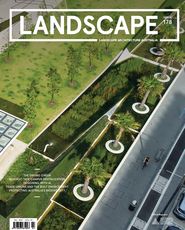
Practice
Published online: 11 May 2023
Words:
Philip Belesky
Images:
Render originally produced by Bush Projects for the City of Melbourne Library rooftop.,
Supplied
Issue
Landscape Architecture Australia, May 2023

